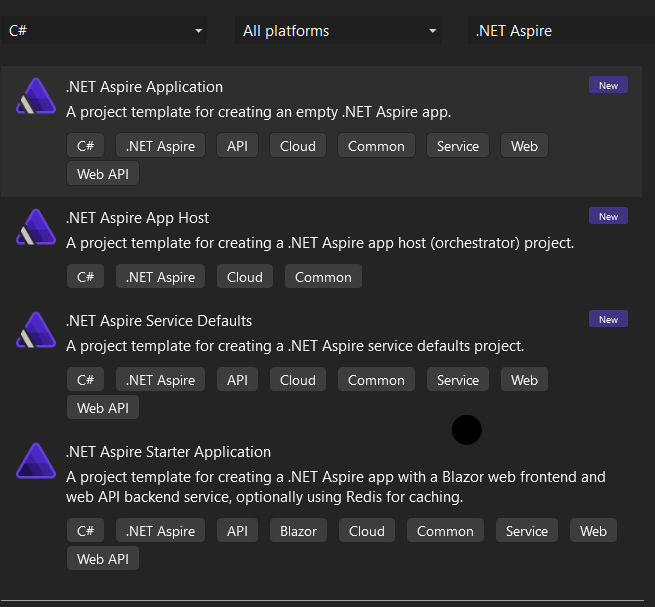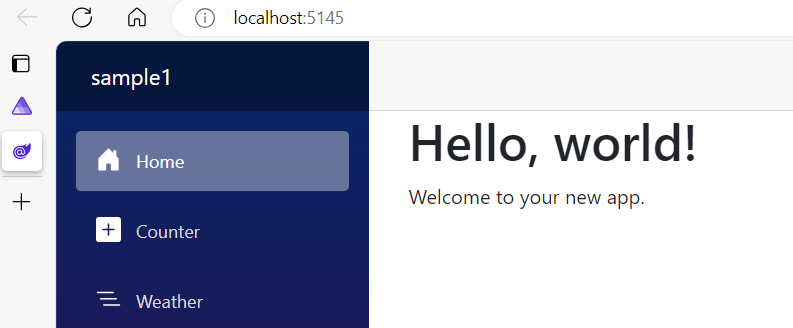.NET Aspire and Redis
February 25, 2024 - 7 mins read time - 1286 words - garrardkitchen
First look into .NET Aspire
TL;DR: See here for why AZD is not yet supported.
I decided to give .NET Aspire a try. I’m yet to watch an online tutorial but I did watch its announcement a few months ago. At the time I did think YAGNI. For me, it didn’t make much sense. Either that, or it just wasn’t being explained well enough. Enthusiasm alone isn’t enough to promote a new tool. Since then, I’ve seen many tweets. So, over the last month or so, I’ve gradually grasped its raison d’être.
Last night, with some time to kill, I asked Copilot to send me some YT links so I could learn more. But Copilot refused to share any YT links. It only gave me some MS Learn links. One of them took me to the Samples GH repo.
The first time I opened a sample project, the Visual Studio Community 2022 (Preview) version of VS I was using, asked me to install an Aspire component. It turned out to be the Aspire workload. It was a simple click-and-forget operation. I wish everything in life was that easy.
To avoid this ahead of time you can:
.NET Aspire workload
Install the .NET Aspire workload
dotnet workload install aspireor update all workloads
dotnet workload updatethen to confirm version and install status
dotnet workload list
The Wow
The sample I tried to run in Visual Studio did not work, so I switched to another one. Then I saw the dashboard on my personal developer laptop for the first time. I was impressed (a bit). I explored the metrics, logs, and traces. I was more impressed.
I was even more impressed when I saw an example solution that had both a Windows Forms and a WPF app. I wanted to test how easy it was to set up and find a situation that would require me to code.
My sample repo
You can find my sample .NET Aspire applicaton here: https://github.com/garrardkitchen/dotnet-aspire-and-redis-sample
To create your first .NET Aspire application is straight forward. From the menu you choose Create a new project. I filtered on the .NET Apsire project type just to see what’s available:

I selected the .NET Aspire Starter Application and named it sample1. I was prompted to start up Docker for Desktop due to the Redis dependency. The next action I performed was to debug the app to see if anything barked at me. It didn’t and I was presented with the dashboard:

I clicked on the Endpoint link next to the frontendweb project and this Blazor app loaded:

I clicked on the Counter menu option, then the click me button which incremented the on page counter. I clicked away and when I returned the counter had zeroed. Great, I thought, this is where I can start hacking away to see how easy it is to persist this to the redis cache. The remainder of this post covers what I did.
Persisting a Counter to Redis cache
Ref: https://learn.microsoft.com/en-us/dotnet/aspire/fundamentals/setup-tooling?tabs=visual-studio
Redis Dependency
First off, I needed a new pre-release NuGet package for this to work:
dotnet add package Aspire.StackExchange.Redis.DistributedCaching --prerelease
Next I added this so the necessary types get added to the service collection, by adding the following to Program.cs in sample1.Web :
builder.AddRedisDistributedCache("cache");
RedisClient
I then created a Redis Client that I could use to call from the counter razor page to obtain and update the counter value. This is that code:
👉 I’ve not chosen to use the incr type
👉 Redis stores these string as a hash types
using Microsoft.Extensions.Caching.Distributed;
namespace sample1.Web;
public class RedisClient(IDistributedCache cache)
{
public async Task<int> GetCounterAsync(string key)
{
var value = await cache.GetStringAsync(key);
return value == null ? 0 : int.Parse(value);
}
public async Task SetCounterAsync(string key, int value)
{
await cache.SetStringAsync(key, value.ToString());
}
}
Dependency Injection
I then added this Redis Client to the service collection, again, in the this sample1.Web’s Program.cs file:
builder.Services.AddScoped<RedisClient>();
Razor page
The last piece to this jigsaw is the counter razor page. There’s a few different pieces to do here so to help I’ve decomposed these to steps.
Step 1: Inject this new RedisClient into the page:
@inject RedisClient RedisClient
Step 2: Overwrite the page’s OnInitializedAsync implementation in order for us to be able to get our counter from our redis cache:
protected override async Task OnInitializedAsync()
{
currentCount = await RedisClient.GetCounterAsync("counter");
}
Step 3: We now need to update this counter when the button is pressed:
private async Task IncrementCount()
{
currentCount++;
await RedisClient.SetCounterAsync("counter", currentCount);
}
This is what the resulting page looks like this:
@page "/counter"
@rendermode InteractiveServer
@inject RedisClient RedisClient
<PageTitle>Counter</PageTitle>
<h1>Counter</h1>
<p role="status">Current count: @currentCount</p>
<button class="btn btn-primary" @onclick="IncrementCount">Click me</button>
@code {
private int currentCount = 0;
protected override async Task OnInitializedAsync()
{
currentCount = await RedisClient.GetCounterAsync("counter");
}
private async Task IncrementCount()
{
currentCount++;
await RedisClient.SetCounterAsync("counter", currentCount);
}
}
I felt that what I had done was logical and flowed well. I do have experience [limited] with Blazor pages so I did go into this feeling confident and that this was not going to be too much of a stretch.
Just like that, I was all set to run the app! I’m delighted to announce it worked flawlessly and as intended, like most of the code I write 👀.
Confirmation of counter persistence
I couldn’t leave it there. I had to make sure the counter was being written to the cache. Nothing fancy, all I did was I exec’ed into the running container, and then ran a few cli commands.
To get the current value of the counter, use:
redis-cli hget counter "data"
I also update the counter then refresh the page to see it reflect this change:
redis-cli hset counter "data" 25
I also looked at the distributed tracing to get confirmation of this. Here’s an example of this:

And that was that. I was able to take a sample Aspire app and perist a counter value to Redis cache with very little effort. All in all, this was a positive DevEx.
Conclusion
.NET Aspire appears to offer that simplicity glue that is very much missing and I must admit, it does looks great from an inner loop perspective. I’m yet to evaluate its CD approach and how it handles the provisioning of the supporting infrastructure. I see from Deploy a .NET Aspire app using AZD that both bicep and Terraform are supported in that scernario. This will be my next step. I am also reassured that the tech that I’m using on various projects, as a direct result of my research, such as bicep, TF, AZD and ACA, is being utilized here as well. I do hope the wow and positive DevEx continues.
Addendum
I added this section a few days after posting the original article
Well, I couldn’t wait to use AZD to deploy my sample app. Sadly, this didn’t go too well.
I got this error [condensed] at the deploy application stage:
error CONTAINER1013: Failed to push to the output registry: The request was canceled due to the configured HttpClient.Timeout of 100 seconds elapsing
I managed to deploy most of the infra plus 2 ACAs (apiserver and cache) with the azd up command but failed to deploy webfrontend. On retry, it fails this time with apiservice which it had previously deployed successfully. I retried with azd deploy webfrontend but I saw a repeat of the the above.
I found this GH issue that confirms this behaviour ➡️ https://github.com/Azure/azure-dev/issues/3225 and that it’s yet to be addressed.
So, sadly you can’t use AZD with .NET Aspire, yet. It’s a real shame this hasn’t been made public.